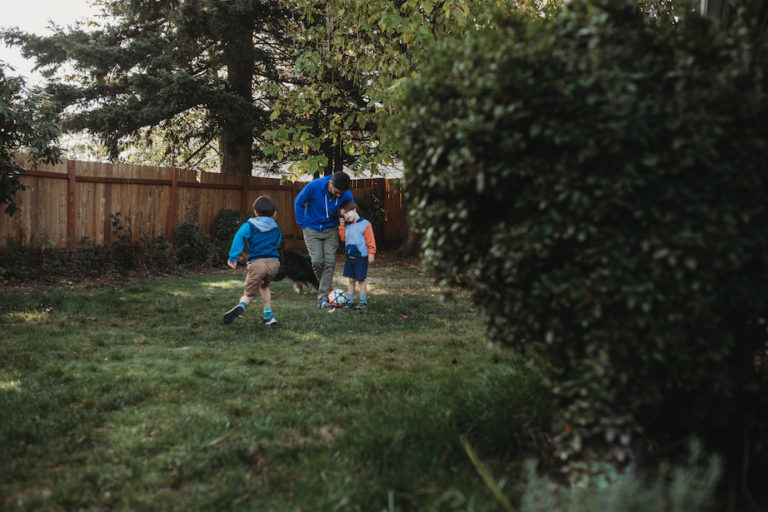Fact: Landscaping is a great investment.
It’s well established that a nicely designed and landscaped yard does wonders for the market value of your home. In one study that surveyed seven states, less than $250 in “flower color” added nearly $1,000 to the perceived value of a home. Further, plant size accounted for an incredible 41 percent of the total perceived value of a home! Who doesn’t love a magnificent king of a tree, but still, wow. And that’s just plants.
You probably can’t do everything you’d like in one season, even if your yard is tiny. So check out the 12 tips for creating a valuable yard below and make a multi-year plan that starts with trees, curb appeal, and of course whatever will increase your quality of life the most — maybe that deck you envision off the living room.
To ensure that your plantings thrive, consider getting your soil tested by a local garden center, university, or county agricultural extension. They’ll tell you how to enrich it.
1. Curb appeal
Anything that makes your home more attractive from the street is a big plus for market value, so the front yard is a good place to begin your efforts. Check out these can’t-miss rules for building curb appeal.

2. Low maintenance
We’re all busy, right? Landscaping that even looks high-maintenance could give future buyers pause (unless your home is at the high end, and hiring a landscaping service is par for the course).
What does this mean for your yard? Choose perennials over annuals, avoiding types that need to be divided frequently to keep from turning into flowerless clumps of root. Consider an irrigation system for easy watering, or better yet, especially if you’re in a dry zone, xeriscaping. Choose durable materials for patios and other structures. Think hard before putting in a pool — you won’t get your investment back, and some buyers will see it as a liability.

3. Less lawn
See number 2. Mowing takes time, every weekend. Go for ground covers and turf-like no-mow grasses. Put in wide planting beds and extend them even farther with mulched borders. Here’s more on why and how to rethink your lawn.

4. Trees
Almost everything you add to your home starts depreciating on day one, but not trees. Trees appreciate over time. (Be thoughtful about fruit trees, though. The home-grown food they provide can be a big plus, but they do require more care.)
Even trees near your property increase its value. Years of studies show that leafy neighborhoods have higher property values and lower crime rates. Trees are infrastructure! If your neighborhood is short on trees, inquire with the city about planting street trees, or launch an initiative with your neighbors.
Keep in mind that some trees (even some popular species) don’t work well in the typical yard. Check out our tips on choosing the right tree for your yard.

5. Living space
Outdoor living space is high on the list of equity-building projects. Keep a patio or deck close to the kitchen for al fresco dining. You also want to keep it in proportion to your yard: a small patio in a large yard might look like an afterthought, while a huge one in a small yard will leave you without green space. Make sure there’s some privacy from neighbors (for your sake and theirs). Which brings us to number 6 …

6. Privacy
Done right, walls and fences can be beautiful. Check local codes for height restrictions, and be absolutely certain of your property lines (make sure your neighbors share your certainty). Alternatively, grow a “fence” of trees or hedges, especially if you need height — plant height isn’t usually limited by ordinances. Tall shade trees will shield your second story from neighbors’ windows.
Structures like pergolas, arbors, and trellises can be nice, often friendlier options, shielding and creating a psychological buffer without completely blocking views, light, and breezes. Is your place close to a road or a noisy school? Beyond their natural appeal, fountains (see number 11) can create aural privacy, masking traffic and voices.

7. Good design
Are you addicted to browsing garden ideas on Houzz or Pinterest? That’s not wasted time! The seven-state survey we mentioned earlier indicated that “design sophistication” was the most important factor in landscaping’s ability to boost a home’s perceived value (followed by plant size, and then the diversity of the plants).
One budget-conscious option is to invest in a professional landscaper for the design and then execute it yourself over time. Or see if there’s a garden club near you. Some club members might be more than happy to exercise their inner designer by coming over and showering you with ideas.

8. Energy savings
More and more homebuyers are concerned with energy efficiency. According to the US Department of Energy, strategically placed trees can save up to 25% of the energy used by a typical household, reducing air conditioning costs with their shade, and heating costs when acting as a windbreak.

9. Seasonal balance
Try to design in some interest for every season. Evergreens take the gray out of winter. Holly berries stand out beautifully in the snow. Some trees and shrubs reveal sculptural branching patterns when they drop their leaves. Check out 15 Striking Plants for Winter Color at HGTV.

10. Native and sustainable plants
Native plants are growing in popularity, and for good reason. They’re well adapted to their environment, so they’re more likely to thrive with little maintenance and less water.

11. Water
A water feature as simple as a small fountain can give an outdoor hang-out space a feeling of sanctuary. Be mindful of the maintenance issue, though. A pond filled with koi fish can cut both ways — alarming to some buyers, love at first sight for others.

12. Lighting
Those little solar-powered lights that stake into the ground do more than keep you and your guests from tripping. They show off the garden at night, silhouetting trees and expanding the sense of space. Just be sure they have hoods — light pollution is a serious issue, and you and your neighbors probably want to see the stars too.

Reminder: check your homeowners insurance. Any time you do something that significantly increases the value of your home — including landscaping — it’s smart to check in with your insurance company about more coverage against loss. Or have you created a new liability issue? A deck, patio, or hot tub can both add value to your home and increase the likelihood of accidents.

